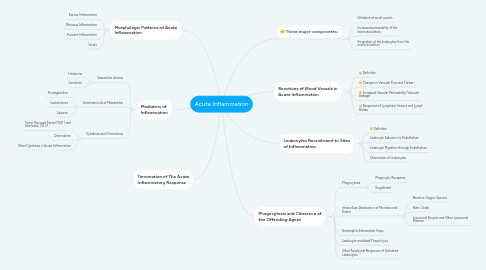Acute Inflammation
by Qonitta D. Khumaira


1. Termination of The Acute Inflammatory Response
2. Mediators of Inflammation
2.1. Vasoactive Amines
2.1.1. Histamine
2.1.2. Serotonin
2.2. Arachidonic Acid Metabolites
2.2.1. Prostaglandins
2.2.2. Leukotrienes
2.2.3. Lipoxins
2.3. Cytokines and Chemokines
2.3.1. Tumor Necrosis Factor (TNF ) and Interleukin I (IL-I)
2.3.2. Chemokines
2.3.3. Other Cytokines in Acute Inflammation
3. Morphologic Patterns of Acute Inflammation
3.1. Serous Inflammation
3.2. Fibrinous Inflammation
3.3. Purulent Inflammation
3.4. Ulcers
4. Three major components:
4.1. Dilatation of small vessels
4.2. Increased permeability of the microvasculature
4.3. Emigration of the leukocytes from the microcirculation
5. Reactions of Blood Vessels in Acute Inflammation
5.1. Definition
5.2. Changes in Vascular Flow and Caliber
5.3. Increased Vascular Permeability (Vascular leakage)
5.4. Responses of Lymphatic Vesse;s and Lymph Nodes
6. Leukocytes Recruitment to Sites of Inflammation
6.1. Definition
6.2. Leukocyte Adhesion to Endothelium
6.3. Leukocyte Migration through Endothelium
6.4. Chemotaxis of Leukocytes
7. Phagocytosis and Clearance of the Offending Agent
7.1. Phagocytosis
7.1.1. Phagocytic Receptors
7.1.2. Engulfment
7.2. Intracellular Destruction of Microbes and Debris
7.2.1. Reactive Oxygen Species
7.2.2. Nitric Oxide
7.2.3. Lysosomal Enzyme and Other Lysosomal Proteins

